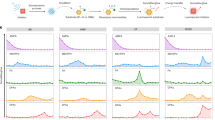Abstract
Molecular imaging probes for biomarker-based diagnosis typically target, with limited sensitivity, a single molecular process or event in a complex biological system. Here, we show that the macromolecular near-infrared poly(ethylene glycol)-conjugated iridium (iii) complex can be designed to successively respond to tumour acidity and hypoxia while amplifying detection sensitivity via signal propagation. We used the probe to detect, by near-infrared imaging, primary tumours and metastatic tumour nodules as small as 1 mm in mice, and to measure the in vivo metabolic rate of cancer cells. We anticipate that probes for imaging coupled biological events with amplified detection sensitivity will offer opportunities for enhanced molecular diagnostics and image-guided biomedical applications.
This is a preview of subscription content, access via your institution
Access options
Access Nature and 54 other Nature Portfolio journals
Get Nature+, our best-value online-access subscription
$29.99 / 30 days
cancel any time
Subscribe to this journal
Receive 12 digital issues and online access to articles
$99.00 per year
only $8.25 per issue
Buy this article
- Purchase on Springer Link
- Instant access to full article PDF
Prices may be subject to local taxes which are calculated during checkout





Similar content being viewed by others
References
Jacobs, T. W., Gown, A. M., Yaziji, H., Barnes, M. J. & Schnitt, S. J. HER-2/neu protein expression in breast cancer evaluated by immunohistochemistry. A study of interlaboratory agreement. Am. J. Clin. Pathol. 113, 251–258 (2000).
Cheng, T. C., et al. An activity-based near-infrared glucuronide trapping probe for imaging β-glucuronidase expression in deep tissues. J. Am. Chem. Soc. 134, 3103–3110 (2012).
Webb, B. A., Chimenti, M., Jacobson, M. P. & Barber, D. L. Dysregulated pH: a perfect storm for cancer progression. Nat. Rev. Cancer. 11, 671–677 (2011).
Zhou, K. et al. Multicolored pH-tunable and activatable fluorescence nanoplatform responsive to physiologic pH stimuli. J. Am. Chem. Soc. 134, 7803–7811 (2012).
Brahimi-Horn, M. C. & Pouysségur, J. Oxygen, a source of life and stress. FEBS Lett. 581, 3582–3591 (2007).
Pennacchietti, S. et al. Hypoxia promotes invasive growth by transcriptional activation of the met protooncogene. Cancer Cell 3, 347–361 (2003).
Xue, S. et al. Protein MRI contrast agent with unprecedented metal selectivity and sensitivity for liver cancer imaging. Proc. Natl Acad. Sci. USA 112, 6607–6612 (2015).
Oyewumi, M. O., Yokel, R. A., Jay, M., Coakley, T. & Mumper, R. J. Comparison of cell uptake, bio-distribution and tumor retention of folate-coated and PEG-coated gadolinium nanoparticles in tumor-bearing mice. J. Control. Release 95, 613–626 (2004).
Han, H. S. et al. Quantum dot/antibody conjugates for in vivo cytometric imaging in mice. Proc. Natl Acad. Sci. USA 112, 1350–1355 (2015).
Voura, E. B., Jaiswal, J. K., Mattoussi, H. & Simon, S. M. Tracking metastatic tumor cell extravasation with quantum dot nanocrystals and fluorescence emission-scanning microscopy. Nat. Med. 10, 993–998 (2004).
Ke, S. et al. Near-infrared optical imaging of epidermal growth factor receptor in breast cancer xenografts. Cancer Res. 63, 7870–7875 (2003).
Sokolov, K. et al. Real-time vital optical imaging of pre-cancer using anti-epidermal growth factor receptor antibodies conjugated to gold nanoparticles. Cancer Res. 63, 1999–2004 (2003).
Lee, E. S., Gao, Z. & Bae, Y. H. Recent progress in tumor pH targeting nanotechnology. J. Control. Release 132, 164–170 (2008).
Ma, X. et al. Ultra-pH-sensitive nanoprobe library with broad pH tunability and fluorescence emissions. J. Am. Chem. Soc. 136, 11085–11092 (2014).
Gallo, K., Assanto, G. & Stegeman, G. I. Efficient wavelength shifting over the erbium amplifier bandwidth via cascaded second order processes in lithium niobate waveguides. Appl. Phys. Lett. 71, 1020–1022 (1997).
Walker-Samuel, S. In vivo imaging of glucose uptake and metabolism in tumors. Nat. Med. 19, 1067–1072 (2013).
Henze, A. T. et al. Loss of PHD3 allows tumors to overcome hypoxic growth inhibition and sustain proliferation through EGFR. Nat. Commun. 5, 5582 (2014).
Chen, H. et al. Selective phosphorescence chemosensor for homocysteine based on an iridium (iii) complex. Inorg. Chem. 46, 11075−11081 (2007).
Lin, W. et al. A ratiometric fluorescent probe for cysteine and homocysteine displaying a large emission shift. Org. Lett. 10, 5577–5580 (2008).
Denko, N. C. Hypoxia, HIF1 and glucose metabolism in the solid tumor. Nat. Rev. Cancer 8, 705–713 (2008).
Sabharwal, S. S. & Schumacker, P. T. Mitochondrial ROS in cancer: initiators, amplifiers or an Achilles’ heel? Nat. Rev. Cancer 14, 709–721 (2014).
Shi, P. et al. A smart “sense-act-treat” system: combining a ratiometric pH sensor with a near infrared therapeutic gold nanocage. Adv. Mater. 26, 6635–6641 (2014).
Sun, D. et al. pH-responsive reversible PEGylation improves performance of antineoplastic agent. Adv. Healthc. Mater. 4, 844–855 (2015).
Wang, Y. et al. A nanoparticle-based strategy for the imaging of a broad range of tumors by nonlinear amplification of microenvironment signals. Nat. Mater. 13, 204–212 (2014).
Krishna, M. C. et al. Overhauser enhanced magnetic resonance imaging for tumor oximetry: coregistration of tumor anatomy and tissue oxygen concentration. Proc. Natl Acad. Sci. USA 99, 2216–2221 (2002).
Papkovsky, D. B., Ponomarev, G. V., Trettnak, W. & O’Leary, P. Phosphorescent complexes of porphyrin ketones: optical properties and application to oxygen sensing. Anal. Chem. 67, 4112–4117 (1995).
Papkovsky, D. B. Methods in optical oxygen sensing: protocols and critical analyses. Methods Enzymol. 381, 715–735 (2004).
Zheng, X. et al. Hypoxia-specific ultrasensitive detection of tumors and cancer cells in vivo. Nat. Commun. 6, 5834 (2015).
Vahrmeijer, A. L., Hutteman, M., van der Vorst, J. R., van de Velde, C. J. & Frangioni, J. V. Image-guided cancer surgery using near-infrared fluorescence. Nat. Rev. Clin. Oncol. 10, 507–518 (2013).
Troyan, S. L. et al. The FLARE intraoperative near-infrared fluorescence imaging system: a first-in-human clinical trial in breast cancer sentinel lymph node mapping. Ann. Surg. Oncol. 16, 2943–2952 (2009).
Tentler, J. J. et al. Patient-derived tumour xenografts as models for oncology drug development. Nat. Rev. Clin. Oncol. 9, 338–350 (2012).
Longo, D. L. et al. In vivo imaging of tumor metabolism and acidosis by combining PET and MRI-CEST pH imaging. Cancer Res. 76, 6463–6470 (2016).
Jiang, T . et al. Tumor imaging by means of proteolytic activation of cell-penetrating peptides. Proc. Natl Acad. Sci. USA. 101, 17867–17872 (2004).
Savariar, E. N. et al. Real-time in vivo molecular detection of primary tumors and metastases with ratiometric activatable cell-penetrating peptides. Cancer Res. 73, 855–864 (2013).
Urano, Y. et al. Selective molecular imaging of viable cancer cells with pH-activatable fluorescence probes. Nat. Med. 15, 104–109 (2009).
Gallagher, F. A. et al. Magnetic resonance imaging of pH in vivo using hyperpolarized 13C-labelled bicarbonate. Nature 453, 940–944 (2008).
Semenza, G. L. Oxygen sensing, homeostasis, and disease. N. Engl. J. Med. 365, 537–547 (2011).
Yu, X., Zhang, Z. L. & Zheng, S. Y. Highly sensitive DNA detection using cascade amplification strategy based on hybridization chain reaction and enzyme-induced metallization. Biosens. Bioelectron. 66, 520–526 (2015).
Tian, T. et al. Sensitive and convenient detection of microRNAs based on cascade amplification by catalytic DNAzymes. Chem. Eur. J. 19, 92–95 (2013).
Wang, X. D. et al. Ultra-small, highly stable, and sensitive dual nanosensors for imaging intracellular oxygen and pH in cytosol. J. Am. Chem. Soc. 134, 17011–17014 (2012).
Shuhendler, A. J., Pu, K., Cui, L., Uetrecht, J. P. & Rao, J. Real-time imaging of oxidative and nitrosative stress in the liver of live animals for drug-toxicity testing. Nat. Biotechnol. 32, 373–380 (2014).
Doolittle, E. et al. Spatiotemporal targeting of a dual-ligand nanoparticle to cancer metastasis. ACS Nano 9, 8012–8021 (2015).
Zheng, X. et al. Dataset for ‘Successively activatable ultrasensitive probe for imaging tumour acidity and hypoxia’ figsharehttp://dx.doi.org/10.6084/m9.figshare.4729765 (2017).
Acknowledgements
This work was supported by the Natural Science Foundation of China (grant nos. 51690153, 21474045 and 51422303), the Specialized Research Fund for the Doctoral Program of Higher Education, and the Program for Changjiang Scholars and Innovative Research Team in University (PCSIRT), Ministry of Education of China.
Author information
Authors and Affiliations
Contributions
X.Z., H.M. and X.J. conceived and designed the research. X.Z., D.H. and W.W. performed the experiments. X.Z., H.M., X.J. and B.L. analysed the data and wrote the manuscript. X.J. supervised the project.
Corresponding author
Ethics declarations
Competing interests
The authors declare no competing financial interests.
Supplementary information
Supplementary Information
Supplementary figures, tables, methods and references. (PDF 6892 kb)
Rights and permissions
About this article
Cite this article
Zheng, X., Mao, H., Huo, D. et al. Successively activatable ultrasensitive probe for imaging tumour acidity and hypoxia. Nat Biomed Eng 1, 0057 (2017). https://doi.org/10.1038/s41551-017-0057
Received:
Accepted:
Published:
DOI: https://doi.org/10.1038/s41551-017-0057
This article is cited by
-
A light-activatable theranostic combination for ratiometric hypoxia imaging and oxygen-deprived drug activity enhancement
Nature Communications (2024)
-
In situ self-assembly for cancer therapy and imaging
Nature Reviews Materials (2023)
-
Fluorescence image-guided tumour surgery
Nature Reviews Bioengineering (2023)
-
Biomaterials tools to modulate the tumour microenvironment in immunotherapy
Nature Reviews Bioengineering (2023)
-
Non-invasive molecular imaging for precision diagnosis of metastatic lymph nodes: opportunities from preclinical to clinical applications
European Journal of Nuclear Medicine and Molecular Imaging (2023)



